ARCTIC EXPLORATION:
NORTH WEST PASSAGE: THE PANDORA VOYAGE OF 1876
by Janet Wood
These photographs belonged to our family ancestor, William George Battam
and were taken in 1876 during the expedition to the North West Passage organised by Sir Allen Young.
This was the second such voyage undertaken by Sir Young in his steam ship; the Pandora.
The first had taken place in the previous year, 1875. These photographs are some of the first
to be taken of the Arctic Region. The official photographer on the 1876 voyage was William Grant, a pioneer photographer of the Arctic who was involved with another seven photographic trips to the Arctic. The majority of his work was commissioned by the Dutch and is still preserved in the Netherlands.
 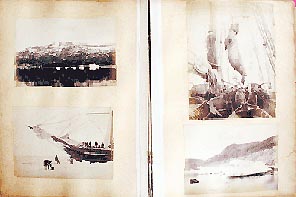
The original 1876 Photographic Album above has been in our family for 128 years.
The album contains 47 original photographs of the Arctic regions.
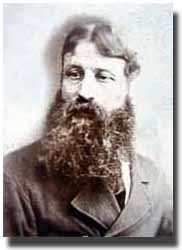
William G Battam. Seaman on board the Pandora (1876 voyage)
The steamer sailed from Southampton in 1876 and headed for the North West Passage.
The young party of sailors were put together by Sir Allen Young in the hope that the yacht
would be able to break through the ice-bound North West Passage in one season and maybe
uncover further details of the fate of Captain Franklin, who had died there in 1847.
However the British admiralty asked Young to change his destination to Smith Sound
as they wished to communicate with the depots of the government expedition, namely; The
British Arctic / Naval North Pole Expedition of 1875-76, lead by George Nares.
Young's endeavour was successful and he was knighted for his services in 1877. Also, every
member of the crew (33) was presented with a specially commissioned Arctic medal for his
participation in the 1876 voyage.
 
Front and back of the Arctic Medal presented by Queen Victoria
(Photos kindly donated by Douglas Wamsley)
PHOTOS FROM THE 1876 ALBUM THAT CONTAINS OVER 40 IMAGES OF THE PANDORA VOYAGE:
The photographs record the events of the Voyage.
The daily routine and activities of the crew, the local people, various remote locations
and the Pandora.

Polar Bear Kill
| 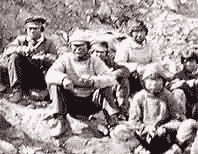
Inuits - Greenland
|
As can be seen in some of these photographs British Arctic explorers in the
19th century wore woollen clothing. These tight clothes caused the men to sweat
during the day, which meant, when they came to put them on again, they would be
stiff, cold and very uncomfortable. Amundsen was quoted as saying,
"in woollen things you have to jump and dance about like a madman before you can get warm."
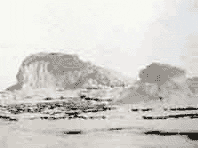
Arctic ice flow. Icebergs |
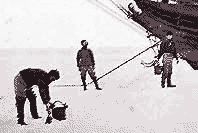
Pandora's crew |

Pandora crew man |
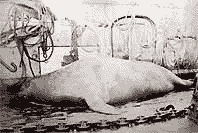
Walrus |

The Pandora |

Walrus kill on display |

The Pandora's crow's nest |

Local children on Pandora |

Play background music, Stan Rogers: North West Passage
If you would like to purchase the CD click on any of the links below.
Amazon-uk Amazon-USA
BIOGRAPHIES:
WILLIAM GEORGE BATTAM (1844-1922):
William Battam was born in St Helier Jersey on 24th July 1844 to John and Elizabeth Battam (maiden name Le Montais). His father was one of the oldest known habour pilots. William sailed the world four times altogether, from the start of his career as a
nine year old cabin boy on an old wind jammer until his retirement from seafaring in 1891.
He served on many renowned vessels including the Brigantine Quiz, the Victoria, (belonging to the P&O line) the Royal Albert and Victoria Yacht, Lord Dunraven’s Yacht and Lord Brassey’s famous Sunbeam, but always maintained that the Arctic exploration on the Pandora had been the most challenging of his distinguished career. After his retirement he settled in Southampton (Eastleigh) where he set up a laundary buisness with his second wife, Eliza. He died on September 17th 1922 aged 78.
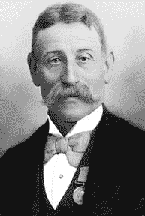
W G Battam proudly wearing his Arctic medal.
SIR ALLEN YOUNG:
Sir Allen William Young was born in Twickenham, Middlesex, England, in 1830.
In 1875 he undertook a private expedition to navigate the
North West Passage in a single season, and to try and find more information about Franklin's
fate, but ice barred his progress, and the expedition failed. Obliged to retrack he returning
to England on the 10th October 1875. In the following year 1876, Sir Allen Young again
undertook another voyage to the Arctic with the same intention, however his plans
were changed when the British Admiralty asked him to communicate with the depots of the
government expedition at Smith Sound. He was later knighted for his services in 1877. In 1879
he published the book; "The Two Voyages of the Pandora in 1875 and 1876" which he funded
himself and gave copies to his close family, friends and crew members.
WILLIAM GRANT: (kindly submitted by Douglas Wamsley)
The photographer, William J.A. Grant of Cullompton, Devon, was born on May
1, 1851. He attended Harrow and Oxford, where according to Allen Young, "he
had made a special study" of the art of photography. Evidently possessed of
independent financial resources, he practiced his specialty for years
afterward for little or no pay, serving on eight arctic expeditions during
the period from 1876 through 1883. His first photographic venture to the
arctic was on board the steam yacht, Pandora, with Allen Young, during which
he produced at least 40 photographs. This first photographic excursion to
the far North for Grant produced a variety of images reflective of the
settlements and people visited while in Greenland, as well as other
documentary photographs meant to verify the locations visited while
searching for records of the British Arctic Expedition commanded by Sir
George Nares.
After his trip with Allen Young, Grant participated on four voyages of the
Willem Barents in the vicinity of the Barents Sea. His photographic work in
these voyages was impressive, and for each trip he produced a high quality
photographic album recording his work. Grant also participated in two other
arctic excursions on British yachts, sailing with Benjamin Leigh Smith on
board Eira in 1880 and again with Smith on board Kara in 1882, producing a
photographic record in each case.
Grant was the most productive and successful arctic photographer in the era
preceding Robert Peary. He was a fellow of both the Royal Photographic
Society and the Royal Geographic Society, and received the Arctic Medal
1875-1876 for his service on Pandora. He died on March 10, 1935 at the age
of 83.
GRANT REFERENCE SOURCES:
Bruyns, Willem F.J. Morzer. Photography in the Arctic, 1876-84: The Work of
William Grant. Polar Record 39 (209): 123-130 (2003).
Wamsley, Douglas and William Barr. Early Photographers of the Arctic. Polar
Record 32 (183): 295-316 (1996).
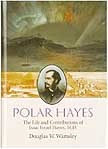
New book by Douglas Wamsley
Polar Hayes: The Life and Contributions of Isaac Israel Hayes, M.D.
Amazon-USA Amazon-UK
THE PANDORA:
 The Pandora was a wooden steamship that was built in 1861 at Pembroke Dockyard, England. After her usefulness as a navy gunboat came to an end she was sold to Sir Allen Young in 1875 so he could use her for his two famous Arctic voyages. (Details above)
The Pandora was a wooden steamship that was built in 1861 at Pembroke Dockyard, England. After her usefulness as a navy gunboat came to an end she was sold to Sir Allen Young in 1875 so he could use her for his two famous Arctic voyages. (Details above)
After the two expeditions, the Pandora was sold in 1878 to the American James Gordon Bennett, who was the newspaper publisher of The New York Herald.
In order to make her ready for her next polar expedition the ship was totally refitted and her hull reinforced. The yacht was also renamed “Jeannette” and when she set sail out of San Francisco on the 8 July 1879 she was under the command of George W. DeLong.
Unfortunately, not long after entering polar waters, some two months after setting sail, the Jeannette became caught in the pack-ice and for the next twenty-two months the ship and her crew had no alternative but to drift with the shifting ice. During this time she
was carried several hundred miles, until on the 12 June 1881 her hull was finally crushed by the thick ice flows and sadly she sank the following morning.
However, the crew did have time to remove three boats, supplies and some equipment from the then doomed Jeannette, but in order to reach open water it meant dragging the boats many miles over rugged ice. This proved to be a very long and arduous task that took months, but there was little choice, as the men knew there was no hope of rescue.
The intention of the crew was to get to the Lena River Delta, nearly 700 miles away on the north Siberian coast, but disaster struck when, after reaching open water, the three boats became separated in a violent storm and one sank. The remaining two, commanded by Delong and Chief Engineer George W. Melville, never met up again.
In the end, of the thirty-plus crew who set off after the ship went down, only thirteen of the men survived; those in George Melville's boat and two from Delong's boat. DeLong did not survive and his body was eventually found in March 1882 after an extensive search by the brave efforts of Melville who returned several times in order to try and find his missing friends.
A journal of the expedition was published in 1883 by DeLong's wife entitled; 'Jeannette'.
SIR JOHN FRANKLIN:
Sir John Franklin was born at Spilsby, Lincolnshire on the 16 April 1786 and was a pioneer of
Arctic exploration. He had already led three successful expeditions before setting off
from the Thames in 1845 in search of the North-West Passage. He took two ships with him -
the Erebus and Terror. Francis Crozier commanded the Terror, whilst James Fitzmaurice commanded the Erebus.
When no word had been heard from the ill-fated Franklin expedition for sometime,
numerous expeditions were put together to try and discover what had happened to the men.
Eventually in 1859 a stone cairn was found at Point Victory containing food and papers
belonging to the Franklin party. The papers confirmed
that all 130 men had in fact died; Franklin in 1847, whilst a
few men survived until 1848. However the information also confirmed that before their
deaths Franklin and his crew had discovered the North-West Passage.
Extra Note: Dr John Rae I know there is some controversy as to whether Franklin was actually the first to discover the Northwest Passage or whether it was in fact, Dr John Rae (1813-1893). In order to be fair I have provided a link to a website about Dr Rae.
BRITISH ARCTIC EXPEDITION OF 1875-76:
The enthusiasm of Great Britain for Arctic discovery had been rekindled in 1874 when the
British Prime Minister announced that an expedition would be despatched in the following year.
Two powerful steamers, the Alert and Discovery, were selected for the service, with Nares as
their leader. Many leaders of government expeditions had little direct knowledge of, or
interest in, arctic exploration. For example, Captain Nares considered the arctic a
"wretched place." This was in sharp contrast to privately organised expeditions, like the
Pandora, who leaders, like Sir Allen Young, were prepared and motivated for Arctic exploration.
The British Arctic Expedition of 1875 worked in some of the most remote northern regions
where communication was very difficult. It was arranged that the crew's mail would be picked up
via a cairn on Careys Island by passing ships. The mail would then be forwarded to Britain
at the first port of call. The same was done in reverse with mail and personal notes from family and friends
in Britain. The Pandora played a part in this delivery service.
NORTH WEST PASSAGE MAPS:
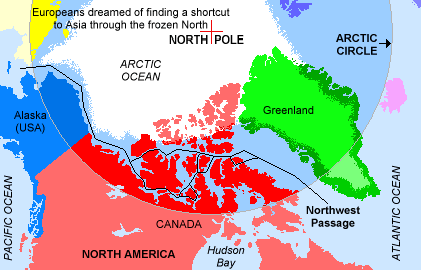
CLOSE UP OF THE NORTH WEST PASSAGE:
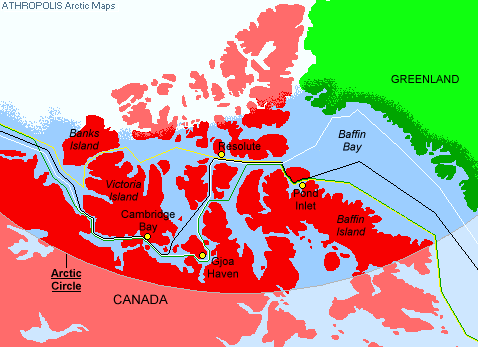
Maps used with kind permission of Athropolis
The Northwest Passage is the famous sea route linking the Atlantic and Pacific Oceans.
It was hoped that the alternative and shorter passage from Europe to Asia would provide an
alternate shipping route and this discovery fuelled many explorers over the centuries.
The passage lies between Canada and Greenland, above the Arctic Circle, but below the north
polar icecap. However, as the sea is frozen over for most of the year, the route never proved
to be commercially viable or practical.
COPYRIGHT NOTICE:
This illustrated article, (excluding maps) is Copyright 2001 by Janet Wood and
must not be reproduced without permission from the
If you copy the text and/or images from this page and use them in any way
without the author’s permission you are in violation of international copyright law. Please note: This copyright notice does not affect any website owner who would like to add an external link to this webpage from their own website. Also, if you feel that your website content would compliment this article please email us and we will be only too happy to consider placing a reciprocal link back to you.
William George Battam's Family Tree
Click here for Elizabeth Greef's Battam Family Tree
|


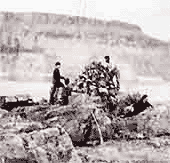















 The Pandora was a wooden steamship that was built in 1861 at Pembroke Dockyard, England. After her usefulness as a navy gunboat came to an end she was sold to Sir Allen Young in 1875 so he could use her for his two famous Arctic voyages. (Details above)
The Pandora was a wooden steamship that was built in 1861 at Pembroke Dockyard, England. After her usefulness as a navy gunboat came to an end she was sold to Sir Allen Young in 1875 so he could use her for his two famous Arctic voyages. (Details above)

